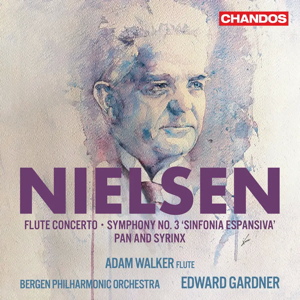
Carl Nielsen (1865-1931)
Pan og Syrinx, Op. 49, FS 87 (1917-1918)
Concerto for Flute and Orchestra, FS 119 (1926)
Symphony No. 3, Op. 27, FS 60 “Sinfonia espansiva” (1910-1911)
Adam Walker (flute), Lina Johnson (soprano), Yngve Søberg (baritone)
Bergen Philharmonic Orchestra/Edward Gardner
rec. 2022, live (Symphony), 2023 (other works), Grieghallen, Bergen, Norway
Chandos CHSA5312 SACD [63]
If I were coming to these works for the first time, or desired this particular programme, I would be thrilled with the results. As with his earlier disc (review), Edward Gardner has demonstrated a real affinity as a Nielsen conductor, and his orchestra assuredly excels in this music. But there is so much competition for these pieces that one may easily have a preference for other recordings of the individual works. Such is the case with me, as I will illustrate below. Néstor Castiglione was blown away by these accounts. I would urge readers to see why (review).
Beginning with symphonic poem Pan og Syrinx, Gardner does not put a foot wrong in as fine rendition as I have heard, with exquisite playing by solo English horn and cello. He captures the mood to perfection. Chandos provides first-rate sound: you can fully appreciate the percussion. Here the competition is largely in collections of Nielsen’s shorter orchestral music. My favourite of those is the Dacapo SACD with the Danish National Symphony under Thomas Dausgaard. It contains the composer’s major non-symphonic orchestral works in splendid accounts that in every way match Gardner’s; the recording is at least the equal of the Chandos. Others, too, do justice to Pan og Syrinx, including Neeme Järvi with the Gothenburg Symphony on DG.
Likewise, Gardner pushes all the right buttons in the Flute Concerto. His soloist Adam Walker is as fine a flautist as any I have heard. The balance between flute and orchestra is exemplary. The other woodwinds, the clarinet and bassoon in particular, are wonderful. The important trombone part is not shortchanged either.
I compared this account with two others I hold in high esteem: Samuel Coles’s with Paavo Järvi and the Philharmonia (Signum Classics, review) and Robert Langevin’s with the New York Philharmonic under Alan Gilbert (Dacapo, review). Both easily equal Walker/Gardner, but I still have a slight preference for Langevin/Gilbert. That is mostly because of George Curran’s outstanding bass trombone sneers, and to a lesser extent Philip Myers’s horn passages. But you could not go wrong with any of these superb recordings of the Flute Concerto.
The Third Symphony may be considered the main event here, not to diminish the importance of the other pieces. From the get-go, Gardner urges his orchestra on, brisk and bullish much of the time in the first movement that never lets up. The waltz-theme midway through is exhilarating. The brass, especially the horns, and the timpani are terrific. The Andante pastorale second movement gives quite a contrast, and is appropriately withdrawn in the drone-like modal base. When the excellent soloists come in with their haunting vocalise, they are nicely distant, as the score requires. Even so, I find the vocal parts even better integrated in the texture of the orchestra in Herbert Blomstedt’s masterful account with the San Francisco Symphony (Decca).
Gardner expresses very well the humour of the following movement, at times gentle and at others sardonic, beginning with assertive horn fanfares. The passage near the end reminds me of Smetana (5:12-5:20). I have always found it delectable, and the orchestra here play it lovingly. Gardner proceeds with the finale’s hymn in an ideal tempo which does not drag the music down or sentimentalize it –quite refreshing. The flow is maintained to the end. My only criticism concerns the moment when the tune returns at the climax. It lacks a little in the majesty compared with Blomstedt’s, whose brass with timpani underpinning are incredibly moving. But the very ending, with the pounding timpani, could not be bettered here or by Blomstedt.
As a further enhancement, Chandos has contributed Paul Griffiths’s notes on the works, articulate and informative as usual. There is also substantial information on the artists. All in all, this disc is a valuable addition to the Nielsen discography. I am not aware of this exact programme elsewhere on disc.
I listened in only two channels. Had I had access to the full SACD sound with the added ambience of the rear channels, I think I would have appreciated it even more.
Leslie Wright
Previous reviews: Néstor Castiglione (March 2024 Recording of the Month) ~ Philip Borg-Wheeler (June 2024)
Buying this recording via a link below generates revenue for MWI, which helps the site remain free.




















